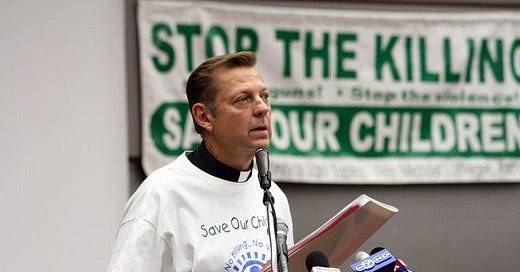
The Archdiocese of Chicago this week announced an allegation against well-known pastor Fr. Michael Pfleger, who is accused of an act of sexual abuse more than 40 years ago.
The case is a high-profile example of the challenges involved in investigating abuse alleged to have happened decades ago. And the case points to a disparity between the way bishops and priests are treated when they face those kinds of charges.
Cardinal Blase Cupich announced Tuesday that Pfleger had been “asked” to immediately step down from his parish and from public ministry while the accusation is investigated; a fairly typical measure for priests facing allegations in recent decades.
But in the U.S., bishops facing “historical allegations” have not always been required - or chosen - to do the same.
Consider the case of Bishop Robert Guglielmone of Charleston, who, in 2019, was accused of sexual abuse dating back to the 1970s. Like Pfleger, Guglielmone asserted his total innocence. But while Pfleger was effectively benched, Guglielmone voluntarily reduced his public appearances to avoid “distracting” from the pastoral work of the diocese. Last month, the Vatican completed its preliminary investigation into the allegations against Guglielmone and dismissed them as “lacking a semblance of truth,” taking the unusual step of clearing the bishop even as a civil suit against him is still pending in a New York court.
Consider also the case of Bishop Nicholas DiMarzio of Brooklyn. This time last year, it was announced that DiMarzio had been accused of abuse alleged to have taken place in the 1970s. DiMarzio, then and now, has asserted his total innocence, and no further accusations have been made.
Cardinal Timothy Dolan is leading the still-ongoing canonical investigation into the accusation and while a year has passed, the accuser has yet to file a lawsuit, despite initially suggesting one would be filed.
As the investigation proceeds, DiMarzio has remained in post as Bishop of Brooklyn, garnering accolades for his leadership of a diocese at the epicenter of the coronavirus pandemic. It was Brooklyn, under DiMarzio’s leadership, that won the Supreme Court injunction which struck down the most draconian and obviously anti-religious lockdown measures in New York, and then across the country.
DiMarzio has always asserted his absolute innocence, and enjoying the presumption of innocence afforded to the accused, given no indication that he might step away from his leadership post. No other American bishop has questioned publicly his right or fitness to do so.
The sum of the disparity should be clear: While priests are usually removed summarily from office as soon as an historic accusation is made, and can be left in legal and ministerial limbo for years, bishops are largely left to judge for themselves if they should remain in office as investigations proceed, and they seem to enjoy from their peers a presumption of innocence not always extended to their diocesan clergy.
To be sure, bishops can choose to step away from ministry while investigated after allegations, but the distinction is that while they are free to make the choice, few priests are afforded that opportunity.
This disparity could, especially among clerics, raise questions about whether it is just that priests and bishops accused of abuse face markedly different circumstances. And the disparity could raise questions about whether bishops are really following through on their promises to hold themselves to the same standards as priests.
Of course every case is different.
In some cases, an immediate “stepping back” from office might be necessary and obvious, while in others, it may be uncalled for. The question of justice may be less about creating a one-size-fits-all approach, and more about who decides what is appropriate - and asking if it is ever appropriate for anyone to judge his own case.
Many of the recent reforms enacted by Pope Francis, most notably Vos estis lux mundi, have been aimed at increasing the accountability of bishops in line with the procedures already in place for priests. Early signs suggest those reforms are being applied with consistency, if not always with transparency.
But if bishops accused of abuse consistently remain in ministry, while priests facing similar accusations do not, the credibility of the Vos estis reforms may come into question.
Reconciling the treatment of priests and bishops on this issue may not be easy: there are canonists who suggest that priests removed while a single and historical allegation is investigated have been treated unfairly, while others suggest the injustice is that bishops remain in ministry in the same circumstance. And regardless of what canonists think, justice requires balancing the rights of the accused with the right of the alleged victim to know allegations are taken seriously, and the right of the community to safety.
Discerning those matters isn’t easy. But generally speaking, consistency is regarded as the right place to begin when working to build equitable systems of justice.
Creating a truly “just” legal mechanism for handling allegations which are decades old is, undoubtedly, a difficult task. It is for this reason that most legal systems, including canon law, have some version of a statute of limitations.
But equally compelling, possibly more so, may be the moral imperative for the Church to try — to do right by generations of victims who have been ignored or silenced, and to restore some measure of confidence in the Church hierarchy. As the process develops, lessons will undoubtedly need to be learned.





